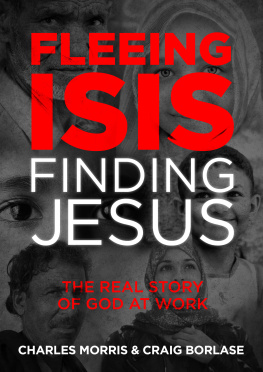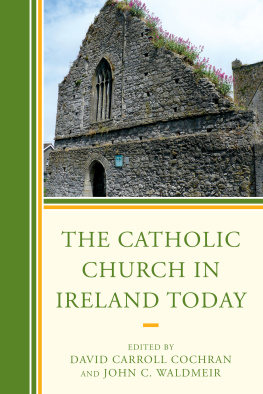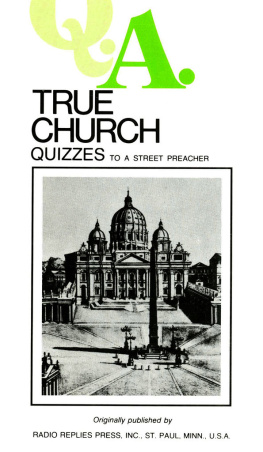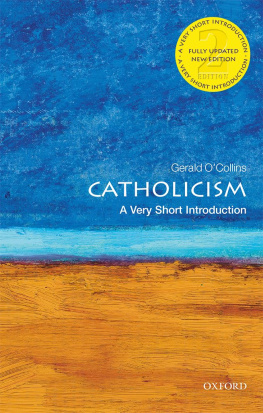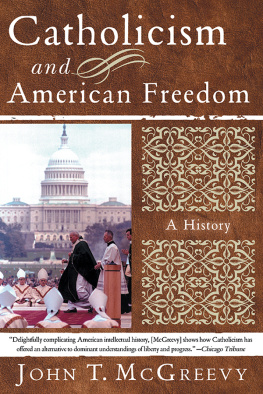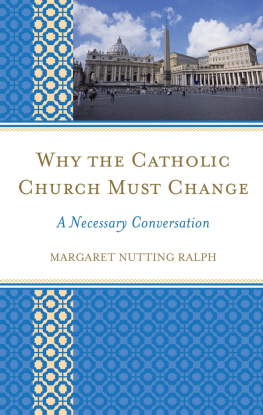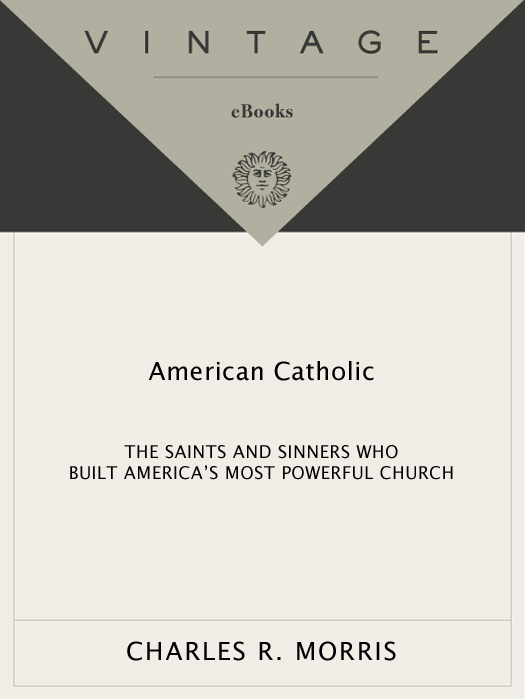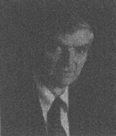Acclaim for CHARLES R. MORRIS s
A MERICAN C ATHOLIC
Sparkling compulsively readable consistently fair. Morris lucidly explains arcane but vital theological topics.
Commonweal
Exhilarating truly exceptional an eminently readable popular history of American Catholicism that, with no exaggeration, is a page-turner.
America
[A] blend of thorough research, original analysis and carefully supported opinion. Morris presents, with great clarity, the problem facing the American Church.
Washington Post Book World
An important addition to the library of anyone who really wants to understand the most important national Catholic church in the world.
Newsday
Reliable and engaging instructive and enjoyable. Every Roman Catholic leader, lay or religious or ordained, should read it.
Catholic Chronicle
Richly detailed. This book will give its members and others a good sense of [American Catholicisms] colorful history.
Cleveland Plain Dealer
Captivating a splendidly written grand narrative of the rise, triumph and present state of an American religious denomination.
Publishers Weekly
Also by CHARLES R. MORRIS
The AARP: Americas Most Powerful Lobby
and the Clash of Generations
Computer Wars (with Charles H. Ferguson)
The Coming Global Boom
Iron Destinies, Lost Opportunities:
The Postwar Arms Race
A Time of Passion: America, 19601980
The Cost of Good Intentions:
New York City and the Liberal Experiment, 19601975
CHARLES R. MORRIS
A MERICAN C ATHOLIC
Charles R. Morris is the author of many books and articles on a wide range of topics. His books include The Cost of Good Intentions: New York City and the Liberal Experiment 19601975, chosen by The New York Times Book Review as one of the Best Books of the Year; and Computer Wars: The Fall of IBM and the Future of Global Technology, selected by Business Week as one of the ten best business books of the year. Mr. Morris is a regular contributor to The Atlantic, including his articles on Catholicism: The Price of Orthodoxy and The Three Ages of the Catholic Church. He lives in New York City.
FIRST VINTAGE BOOKS EDITION, NOVEMBER 1998
Copyright1997 by Charles R. Morris
All rights reserved under International and Pan-American Copyright Conventions. Published in the United States by Vintage Books, a division of Random House, Inc., New York, and simultaneously in Canada by Random House of Canada Limited, Toronto. Originally published in hardcover in the United States by Times Books, a division of Random House, Inc., New York in 1997.
The Library of Congress has cataloged the Times Books edition as follows:
Morris, Charles R.
American Catholic: the saints and sinners who built Americas most powerful church / Charles R. Morris. 1st ed.
p. cm.
eISBN: 978-0-307-79791-9
1. Catholic ChurchUnited StatesHistory19th century.
2. Catholic ChurchUnited StatesHistory20th century.
3. United StatesChurch history19th century.
4. United StatesChurch history20th century. I. Title.
BX1406.2.M67 1997
282.73dc21 9639191
constitutes an extension of this copyright page.
Author photograph Martin Studios
www.randomhouse.com
v3.1
To Simon Michael Bessie
It is a real pleasure to dedicate this book to Mike Bessie. It has consumed more years than I care to count, and throughout Mike has been an enthusiast, a sharp editorial reader, and a wise guide. Im honored to count him as a friend.
Preface
American Catholicism is the countrys largest religious denomination. But it has always been as much a culture as a religion, one defined by its prickly apartness from the broader, secular American culturein America, usually enthusiastically for America, but never quite of America. In its glory days, especially in the 1940s and 1950s, the Catholic Church constructed a virtual state-within-a-state so Catholics could live almost their entire lives within a thick cocoon of Catholic institutions.
The story of American Catholicism is therefore the story of the rise and triumph of a culture, and of the religious crisis that has ensued in the wake of that cultures breakdown. Most of the Churchs much publicized recent problemsthe financial, sexual, and other scandals that are blazoned across the front pagescan be understood as the floundering of an institution suddenly forced to make its way solely as a religion, shorn of the cultural supports that had been the source of its strength.
The fluidity, the individualism, the frankly experimental style that define the American character are in direct opposition to many of the central concepts of Catholicismthe notion of dogma, the principles of authority and hierarchy, the medievalisms. The core tension in the American Church has always been its stiff-necked resistance to the great American assimilationist engine, and the shifting terms of its accommodation with the rest of the country. Yet by the mid-twentieth century, the Church had managed to become a dominant cultural force and, with all its current problems, is arguably still the most successful national Catholic church in the world. Since the story has so many twists and turns, a very brief road map may be in order.
The roots of the modern American Catholic Church are found not in Rome, or in the early Spanish missions, but in nineteenth-century Ireland. What most people understand today as Irish Catholicism was a religious reaction to the holocaust of the Great Potato Famine. The Famine, which actually lasted, with varying degrees of severity, from the mid-1830s to at least 1880, reduced the islands population by half and destroyed the Irish Catholic peasantry. A demoralized nation seized upon a strict, reformed version of Catholicism as a way to rebuild its national identity and underscore its hatred for the Protestant English. The hatred and despair was converted into a moral mission of the Irish racequite explicitly adopted by the Irish Churchto save America and the rest of the English-speaking nations from heresy.
Until famine triggered a massive wave of Catholic Irish immigration to America, the American Church was a small, polyglot affair, quietly adapting to a Protestant country. Just like Protestants, Catholic lay people ran their parishes and usually hired and fired their pastors. Especially in Baltimore and Philadelphia, but even in Yankee Boston, Catholicism was gaining intellectual and social cachet, and a number of prominent ministers converted. In its 1832 session, the U.S. Congress chose a Catholic priest as its chaplain.
The Irish diaspora brought a militant and bureaucratic style of Catholicism and touched off nativist riots in most major cities. A new breed of Irish bishopthe archetype is John Hughes of New Yorkimposed order and discipline on fractious urban dioceses and started building the vast network of Catholic institutions that reinforced religious/ethnic identity and protected lay people from the virus of freethinking. Within a few decades, Irish bosses had taken over almost all big-city political machines using the same techniques employed by their bishops.



